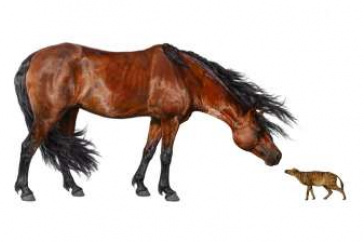Early Mammals Shrank - Twice - During Global Warming in Paleogene Era

Caption:An artist's rendering of Hyracotherium (right) and its modern ancestor, the horse. Researchers found that Hyracotherium body size decreased 19 percent during a global warming event approximately 50 million years ago. Credit: Danielle Byerly, University of Florida
DURHAM, N.H. - When the Earth heated up about 50 million years ago in a series of extreme global warming events, early mammals shrank in response. While this mammalian dwarfism had been previously linked to the largest of these events, University of New Hampshire doctoral student Abigail D'Ambrosia and colleagues connected this dwarfism to a second, smaller so-called hyperthermal, indicating an important pattern that could inform our understanding of current human-caused climate change.
D'Ambrosia presented the team's findings today at the Society of Vertebrate Paleontology's annual meeting in Los Angeles.
Scientists have known that during the largest of these hyperthermals, known as the Paleocene-Eocene Thermal Maximum (PETM), temperatures rose an estimated 9 to 14 degrees Fahrenheit and mammal size shrank. D'Ambrosia wanted to build on this knowledge, which her advisor, UNH professor of geology Will Clyde, put forth in his doctoral dissertation.
"We wanted to find out if this was a repetitive pattern," says D'Ambrosia. "If we knew that, maybe it would help us predict what would happen in a warming event today."
"The fact that it happened twice significantly increases our confidence that we're seeing cause and effect, that one interesting response to global warming in the past was a substantial decrease in body size in mammalian species," adds collaborator Philip Gingerich, a professor of Earth and environmental sciences at the University of Michigan.
The researchers collected teeth and jaw fossils of two early hoofed mammals - Hyracotherium, an early horse the size of a small dog, and Diacodexis, an ungulate - and the primate Cantius in the fossil-rich Bighorn Basin region of Wyoming. "To paleontologists, the Bighorn Basin is littered with fossils. If you walk around with a keen eye, you start seeing all these little tiny teeth," D'Ambrosia says.
Using the size of molar teeth as a proxy for body size, the researchers found that the mammals' body size diminished during a second smaller hyperthermal, called the ETM2. Hyracotherium decreased about 19 percent in size, Diacodexis about 20 percent, and Cantius about 8 percent.
"Interestingly, the extent of mammalian dwarfism may be related to the magnitude of the hyperthermal event," D'Ambrosia says. During the ETM2, which lasted 80,000 to 100,000 years, about half as long as the PETM, temperatures rose an estimated 5 degrees Fahrenheit. During the warmer PETM, which occurred about 2 million years earlier than the ETM2, Hyracotherium had a body size decrease of approximately 30 percent.
Body sizes rebounded following both hyperthermal events.
Because both the PETM and the ETM2 hyperthermals coincided with increased levels of carbon dioxide in the atmosphere, this work could have implications for current climate change study.
"Developing a better understanding of the relationship between mammalian body size change and greenhouse gas-induced global warming during the geological past may help us predict ecological changes that may occur in response to current changes in Earth's climate," says Clyde.
In addition to D'Ambrosia, Clyde, and Gingerich, researchers on the project are Henry C. Fricke of Colorado College and Kathryn Snell of the California Institute of Technology. The research was funded by the National Science Foundation (EAR0958821), the Geological Society of America, the Paleontological Society, and Sigma Xi.
The University of New Hampshire, founded in 1866, is a world-class public research university with the feel of a New England liberal arts college. A land, sea, and space-grant university, UNH is the state's flagship public institution, enrolling 12,300 undergraduate and 2,200 graduate students.
Photographs available to download:
/unhtoday/news/releases/2013/10/images/hyracotherium-(3)-4631.jpg
An artist's rendering of Hyracotherium (right) and its modern ancestor, the horse. Researchers found that Hyracotherium body size decreased 19 percent during a global warming event approximately 50 million years ago.
Credit: Danielle Byerly, University of Florida
/unhtoday/news/releases/2013/10/images/hyrac-jaw-2138.jpg
Jawbone fossil of Hyracotherium, an early horse, collected in the Bighorn Basin region of Wyoming. Researchers found that Hyracotherium body size decreased 19 percent during a global warming event approximately 50 million years ago.
Credit: Abigail D'Ambrosia, University of New Hampshire
Read more: /unhtoday/news/cj_nr/2012/apr/bp02warming.cfm
-30-
Latest News
-
October 30, 2024
-
October 10, 2024
-
October 8, 2024
-
October 3, 2024
-
October 1, 2024
















































